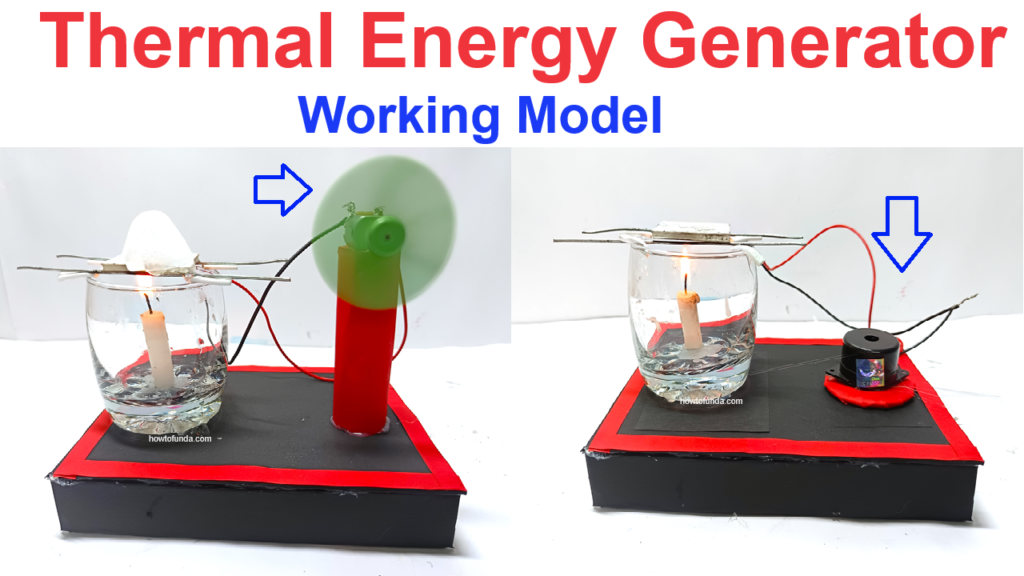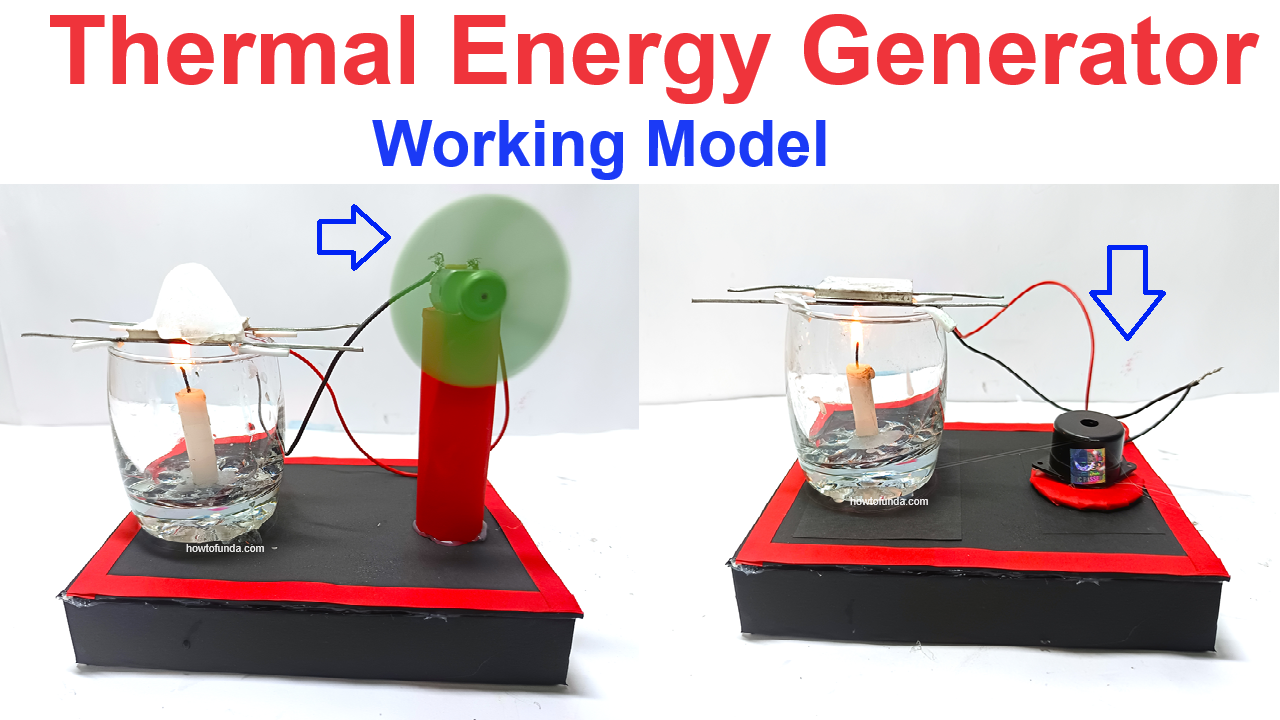Creating a thermal energy (electricity) generator working model using a Thermoelectric Cooler (TEC) or Peltier module is an excellent science project for demonstrating how temperature differences can generate electricity.
This model will use the Seebeck effect, where heat and cold applied to a TEC module generate a voltage, which can then power a small DC motor and a buzzer.

Here’s how you can build this model:
Materials Needed:
- TEC (Thermoelectric Cooler) Module: A Peltier module, which can generate electricity when there is a temperature difference between its two sides.
- Heat Source: A small candle, alcohol burner, or any safe, controlled heat source.
- Cold Source: Ice cubes, cold water, or a cold pack.
- DC Motor: A small low-voltage DC motor (3-6V) to demonstrate the electricity generation.
- Buzzer: A small low-voltage buzzer (3-6V).
- Heat Sink: To help maintain the temperature difference on the cold side of the TEC module.
- Wires: To connect the TEC module to the motor and buzzer.
- Switch: To control the operation of the motor and buzzer.
- Multimeter: To measure the voltage output (optional but useful for demonstration).
- Thermal Paste: To improve thermal conductivity between the heat source, TEC module, and heat sink.
- Cardboard or Wooden Base: To mount and organize the components.
- Glue, Tape, and Scissors: For assembling the model.
Step-by-Step Video Instructions:
1. Preparing the TEC Module:
- Heat Side Preparation: Attach the heat side of the TEC module to a metal plate or directly expose it to the heat source. Apply thermal paste between the TEC module and the metal plate to ensure good thermal conductivity.
- Cold Side Preparation: Attach the cold side of the TEC module to a heat sink. You can place ice cubes, cold water, or a cold pack on the heat sink to maintain a lower temperature.
2. Mounting on the Base:
- Base Setup: Mount the TEC module on a sturdy cardboard or wooden or Glass cup base. Ensure the heat side is easily accessible for the heat source, and the cold side is well insulated or attached to a heat sink.
- Heat Source Placement: Position the heat source (e.g., a candle or burner) under or next to the heat side of the TEC module. Ensure it is stable and safe to prevent accidents.
3. Connecting the Circuit:
- Wiring the TEC Module: Connect the positive and negative terminals of the TEC module to the DC motor and buzzer in parallel. Use wires to make these connections.
- Switch Installation: Install a switch between the TEC module and the motor/buzzer to control the operation. This allows you to demonstrate the effect of turning the system on and off.
- Optional Multimeter: Connect a multimeter in parallel with the motor and buzzer to measure the voltage generated by the TEC module when heat is applied.
4. Operating the Model:
- Apply Heat and Cold: Light the heat source and place it near or under the heat side of the TEC module. At the same time, place ice or a cold pack on the cold side (or ensure the heat sink is in contact with something cold).
- Electricity Generation: As the temperature difference increases, the TEC module will generate a voltage. This voltage will power the DC motor, making it spin, and will activate the buzzer, creating a sound.
- Switch Control: Use the switch to demonstrate the ability to control the flow of electricity, turning the motor and buzzer on and off.
5. Final Touches:
- Labeling: Use markers or labels to clearly mark the different components, such as the TEC module, heat source, cold source, DC motor, and buzzer.
- Safety Precautions: Ensure the heat source is stable and monitored during the demonstration. Use a non-flammable base if possible.
Display and Demonstration:
- Interactive Element: Allow viewers to operate the switch and observe how the temperature difference generates electricity to power the motor and buzzer.
- Explanation: Prepare a brief explanation or a poster to describe the Seebeck effect and how it is utilized in thermoelectric generators.
This model is an excellent demonstration of how thermal energy can be converted into electrical energy, showcasing the principles behind thermoelectric generators and the potential for alternative energy sources.

